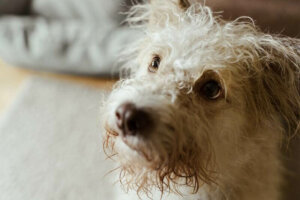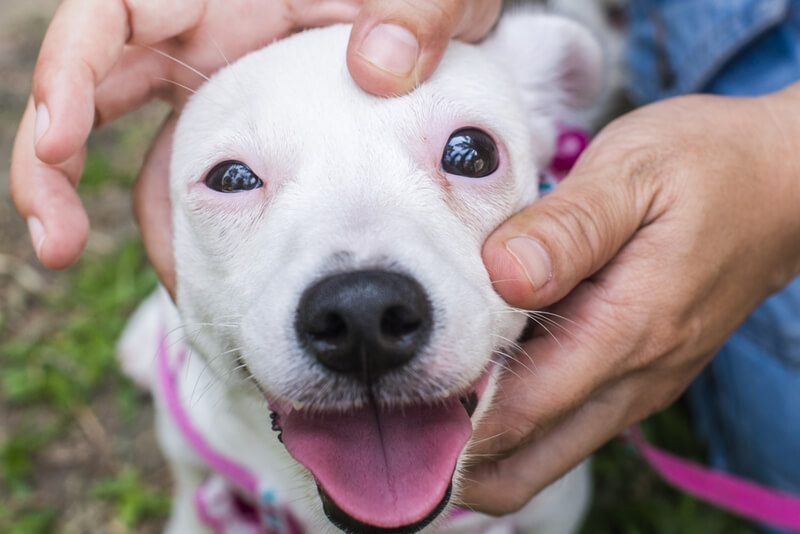Types of Dog Eye Discharge

Most animals secrete tears, and tear production is a natural physiological process. However, there are different types of dog eye discharge, depending on the color and even the scent of the secretions. Take note of the characteristics of these different types of dog eye discharge to find out if your furry friend is developing a disease that you can prevent.
Types of dog eye discharge according to color
Of all the different types of dog eye discharge, light-colored or transparent ones are normal. Dogs with brown coats even tend to have a brownish-colored discharge, but this is also completely normal. A good cleaning on a regular basis is more than enough to control these discharges.
However, even if the color isn’t an alarm signal, if the tearing is excessive, then we recommend that you consult with your vet.

Why does my dog have a green or yellowish discharge?
A greenish or yellowish discharge may be a sign of an ocular pathology. Most often in the spring and summer seasons, you may notice that one of your dog’s eyes is more closed than normal. You should attend to this as soon as possible to avoid further complications.
These eye discharges appear when the dog is suffering from conjunctivitis. The transparent membrane (conjunctiva) covering its eyelid and the white part of the eyeball will be noticeably inflamed. There are many possible causes, and so now we’re going to check the symptoms and treatment.
Types of conjunctivitis detected by conjunctival discharge
Conjunctivitis due to corneal ulceration
This is due to a wound that has damaged the cornea. It may be due to them scratching it with a thorn or stem, or it could occur when they’re playing.
Dogs that sniff around a lot are the most prone to this type of corneal injury. This can cause a cut in the cornea, producing an ulcer that is usually painful. It’s essential to treat this as soon as possible to prevent the problem from worsening until it affects the dog’s vision. The animal may not communicate the pain explicitly.
The veterinarian will make a diagnosis using a special dye called fluorescein and then clean it with saline.
A corneal ulcer treatment involves antibiotics every 8 hours for as long as the veterinarian advises you, and according to the severity of the wound. The medicine will be administered according to the type of infection and a post-treatment check-up will be performed to see the progress in healing.
Infectious conjunctivitis
This develops from a bacterial or viral infection, such as distemper. It can be spread by another dog when the mucous membranes close together. The veterinarian usually prescribes specific antibiotics and even corticosteroids. It’s of utmost importance to detect it as soon as possible if the conjunctivitis is due to the presence of distemper, because this disease can have serious consequences for the animal’s life if not treated in time.

Irritant conjunctivitis
This type of conjunctivitis is caused by chemical irritants and even by smoke from tobacco or car exhausts. Some animals even react to bleach or aerosols.
We must also be careful when bathing our pet with the soap we use to avoid damaging its mucous membranes.
For this type of conjunctivitis, the veterinarian will prescribe a specific type of eye drop.
Foul-smelling discharges
Bacteria that normally live on the surface proliferate in the accumulated humidity and generate a foul-smelling discharge.
Dog breeds such as Cocker Spaniels, poodles (toy), Shih Tzu and Maltese often have excessive secretions and fine hair around the face. Short-nosed dogs (brachycephalic breeds) such as the pug are also prone to this. Bacteria that normally live on the surface proliferate in the accumulated moisture and generate a foul odor.
A veterinary examination will determine whether, in addition to cleaning, they’ll need to treat blocked tear ducts.
In these types of breeds:
- You should keep the hair around the eyes as short as possible.
- It’s advisable to carry out a daily washing of the area once or twice a day.
- The veterinary ophthalmologic antibiotic prescribed by your veterinarian can also be used on the surrounding skin.
- If the surrounding skin is seen to be inflamed, a warm compress (a damp cloth) helps to soothe.
Dogs with eyelash disorders
Dogs that have eyelashes that grow into the eye (distichiasis) and a variety of other eyelash disorders often have excessive discharge due to irritation of the eye. In these cases, eyelid surgery is usually recommended. Once the irritation is removed, the excessive tearing will go away on its own.
As always, this article is for educational purposes to better understand some of your dog’s symptoms. The best thing to do when in doubt is to go to your veterinarian for a consultation and an accurate diagnosis.
Most animals secrete tears, and tear production is a natural physiological process. However, there are different types of dog eye discharge, depending on the color and even the scent of the secretions. Take note of the characteristics of these different types of dog eye discharge to find out if your furry friend is developing a disease that you can prevent.
Types of dog eye discharge according to color
Of all the different types of dog eye discharge, light-colored or transparent ones are normal. Dogs with brown coats even tend to have a brownish-colored discharge, but this is also completely normal. A good cleaning on a regular basis is more than enough to control these discharges.
However, even if the color isn’t an alarm signal, if the tearing is excessive, then we recommend that you consult with your vet.

Why does my dog have a green or yellowish discharge?
A greenish or yellowish discharge may be a sign of an ocular pathology. Most often in the spring and summer seasons, you may notice that one of your dog’s eyes is more closed than normal. You should attend to this as soon as possible to avoid further complications.
These eye discharges appear when the dog is suffering from conjunctivitis. The transparent membrane (conjunctiva) covering its eyelid and the white part of the eyeball will be noticeably inflamed. There are many possible causes, and so now we’re going to check the symptoms and treatment.
Types of conjunctivitis detected by conjunctival discharge
Conjunctivitis due to corneal ulceration
This is due to a wound that has damaged the cornea. It may be due to them scratching it with a thorn or stem, or it could occur when they’re playing.
Dogs that sniff around a lot are the most prone to this type of corneal injury. This can cause a cut in the cornea, producing an ulcer that is usually painful. It’s essential to treat this as soon as possible to prevent the problem from worsening until it affects the dog’s vision. The animal may not communicate the pain explicitly.
The veterinarian will make a diagnosis using a special dye called fluorescein and then clean it with saline.
A corneal ulcer treatment involves antibiotics every 8 hours for as long as the veterinarian advises you, and according to the severity of the wound. The medicine will be administered according to the type of infection and a post-treatment check-up will be performed to see the progress in healing.
Infectious conjunctivitis
This develops from a bacterial or viral infection, such as distemper. It can be spread by another dog when the mucous membranes close together. The veterinarian usually prescribes specific antibiotics and even corticosteroids. It’s of utmost importance to detect it as soon as possible if the conjunctivitis is due to the presence of distemper, because this disease can have serious consequences for the animal’s life if not treated in time.

Irritant conjunctivitis
This type of conjunctivitis is caused by chemical irritants and even by smoke from tobacco or car exhausts. Some animals even react to bleach or aerosols.
We must also be careful when bathing our pet with the soap we use to avoid damaging its mucous membranes.
For this type of conjunctivitis, the veterinarian will prescribe a specific type of eye drop.
Foul-smelling discharges
Bacteria that normally live on the surface proliferate in the accumulated humidity and generate a foul-smelling discharge.
Dog breeds such as Cocker Spaniels, poodles (toy), Shih Tzu and Maltese often have excessive secretions and fine hair around the face. Short-nosed dogs (brachycephalic breeds) such as the pug are also prone to this. Bacteria that normally live on the surface proliferate in the accumulated moisture and generate a foul odor.
A veterinary examination will determine whether, in addition to cleaning, they’ll need to treat blocked tear ducts.
In these types of breeds:
- You should keep the hair around the eyes as short as possible.
- It’s advisable to carry out a daily washing of the area once or twice a day.
- The veterinary ophthalmologic antibiotic prescribed by your veterinarian can also be used on the surrounding skin.
- If the surrounding skin is seen to be inflamed, a warm compress (a damp cloth) helps to soothe.
Dogs with eyelash disorders
Dogs that have eyelashes that grow into the eye (distichiasis) and a variety of other eyelash disorders often have excessive discharge due to irritation of the eye. In these cases, eyelid surgery is usually recommended. Once the irritation is removed, the excessive tearing will go away on its own.
As always, this article is for educational purposes to better understand some of your dog’s symptoms. The best thing to do when in doubt is to go to your veterinarian for a consultation and an accurate diagnosis.
This text is provided for informational purposes only and does not replace consultation with a professional. If in doubt, consult your specialist.








